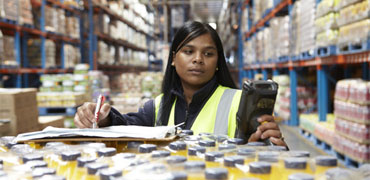When the pandemic hit, news coverage of empty shelves and stockpiling made people uneasy about whether there were enough supplies to go around.
In the next few months, items we usually take for granted often ran out, and it was difficult to get deliveries of certain goods. Coronavirus was a wake-up call. Suddenly, the supply chain was a consumer goods company’s weakest link: research reveals that only 22% of consumer goods companies have a fully integrated supply chain1.
So, what should you focus on to strengthen your operation and improve your supply chain resilience for the future?
1. Deliver on time, every time
Consumer trends and behaviours are changing rapidly, and many customers now expect next day delivery services or reliable ETAs on their orders as a minimum. If a business can’t deliver on time, they can upset their customers and risk them not coming back. But keeping deliveries running to schedule takes more than just avoiding the rush hour. Leading companies are turning to smart fleet management strategies to identify cost-efficient routes, precisely forecast delays, and speed up product transit times.
And it’s not just about your vehicles; how you manage your workforce matters, too. Using digital scheduling is an easy way to build effective rotas and keep operations running smoothly and consistently. It also picks up and eliminates human mistakes that could prove expensive. Many consumer goods companies then build on this efficiency by adding in handheld devices. These can perform multiple tasks, such as scanning and inventory management, as well as acting as a personal digital assistant giving instant visibility on what products are where, speeding up delivery options. They can also have functions like push to talk.
2. Efficiency starts with the warehouse
I’d argue that the warehouse has the biggest role in the supply chain. It’s critical to your overall organisational efficiency, and there’s a direct link to your bottom line. Are you giving it the attention it deserves?
Many organisations have a huge amount of supply chain data they’re not making the most of. Tap into it, and you can identify ways to save critical time and money. Look at using RFID systems, barcodes and scanners across your operation to capture this crucial information. Then, add solutions to make life easier on the ground, like smart glasses or voice directive picking, which let operatives pick stock hands-free, and mobile voice and data communications to boost contact across the warehouse floor.
3. Visibility gives you control
In today’s markets, if you’re going to compete profitably in ecommerce, it’s essential to have complete control and visibility over your stock.
Think about moving to an omnichannel approach, that will integrate all of your platforms in real time, helping you to see right across your supply chain. This comprehensive visibility opens up new ways of managing stock that tightly control quantities, reducing wastage and cutting down on overstocking. This control also means you can keep customers in the loop about where their products are at every stage of the delivery journey: you know where everything is, and your customers are happy. Plus, the clear picture you build up from your comprehensive data is invaluable for predicting future surges in demand.
But first, get the right connectivity
As supply chains grow in complexity, integrating digital technologies is a shortcut to greater visibility, transparency, and efficiency across the entire order fulfilment journey. But many of these devices only work if you’ve got a high-quality network infrastructure in place and your connection across your whole operation is agile, reliable, and secure.
We support consumer goods companies with warehouse efficiency and inventory management solutions, as well as a wide range of powerful, connectivity options that include SD-WAN, 5G and cloud technologies. We also have the right experience to combine technology, expertise, and security to support your specific needs or requirements.
Find out how you can access these innovations and transform your supply chain by downloading our latest brochure or by visiting Digital Consumer Goods.
1KPMG, 2018, Global Consumer Executive Top of Mind Survey.

